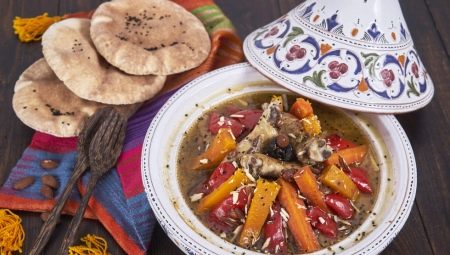The preparation of exotic dishes according to all culinary canons often requires the use of special devices that give the food an authentic taste and the correct consistency. Tajine also belongs to this category - a special type of utensil that allows you to always get excellent results in the kitchen. It is especially common in African countries, where most of the dishes are cooked on an open fire.
In tazhin meat, stewed vegetables are excellent. With such a device, baking and other methods of long cooking will become available even to not too experienced housewives.
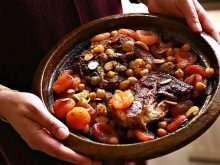
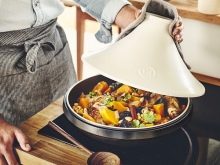
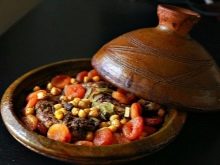
What kind of dishes?
This is traditional for Moroccan cuisine. the vessel consists of a cap of an unusual conical shape with a flat top and a base, where the products are laid. Tajines (Tajines) of various capacities, sizes are produced. The main thing remains one - the method of cooking, and it has been known since the days of the ancient Maghreb. And over the centuries of its use, tajin and the dishes prepared in it have not been criticized.
Traditional for Morocco, this type of tableware easily took root in France, which for many years owned African colonies. Today, it prepares restaurant dishes, indulge in homemade delights of wholesome cooking. Tajine itself looks like wide base pot made of ceramic or metal. The height of the lid is on average three times the size of the sides - this is necessary for the formation of a special microclimate inside. In the conical part there is a small hole that removes excess steam.
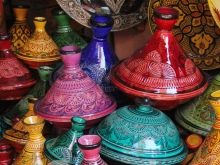

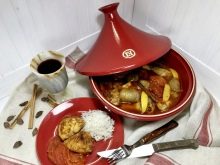
In tajine, it is customary to cook meat, poultry - it is here that they acquire special taste value, become soft and tender. Due to the height of the lid, the cooking process in a closed vessel occurs as follows:
- during cooking, boiling water rises;
- condensed steam flows down the walls to the base of the pot and evaporates again;
- cooking takes place immediately according to two technologies: with direct heating of the bottom and with steam action from above.
Due to the continuity of the process, the dishes inside do not burn, they are cooked with a minimum loss of taste, and they are incredibly tender. Not surprisingly, in France, cafes that serve Tajin dishes are considered some of the most popular.
And having mastered the use of such dishes at home, you can significantly diversify a healthy diet.
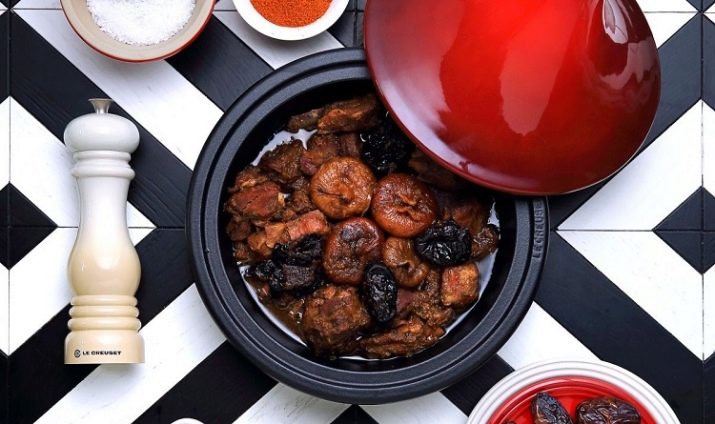
What is it used for?
Tajine is needed for the preparation of most dishes of North African and Moroccan cuisines. The food in it is pre-fried in oil, and then left to simmer over low heat. It is also possible to cook by stewing, in which case the ingredients incorporated inside are simply flavored with a small amount of water. The most commonly used raw materials are meat, poultry, fish, fruits or vegetables. Flawless cereals, legumes and other vegetarian foods are flawlessly obtained.
Food prepared in a special vessel is also called Tajin. With this method of heat treatment, the tastes of spices, dried fruits, spices and herbs are more pronounced. Nuts, honey, ginger go well with tazhin. It is important to understand that in North Africa this cooking method is not everyday - the duration of the heat treatment makes it inconvenient for constant use.
But on holidays or when preparing meals for the future, it is absolutely indispensable. Tazhin allows you to master the creation of food using complex, multi-component recipes - due to the fusion of tastes and aromas, the result is always obtained exactly as it should.
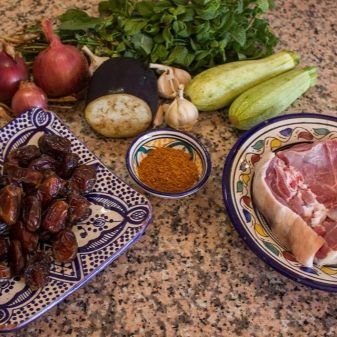
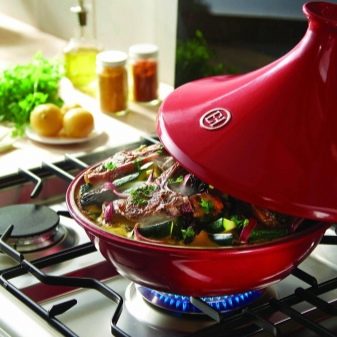
Materials
Traditional Tajine is completely ceramic vessel. In Morocco, it is used not only for cooking, but also for serving. Accordingly, it is customary to choose beautiful, original vessels with national color. But other options are possible.
Features of ceramic, cast iron and other types of Moroccan dishes should be considered separately, taking into account the heating method, which is planned to be used during culinary experiments.
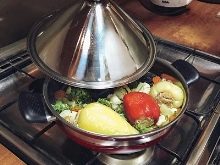
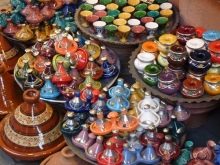
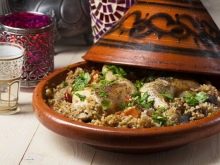
Clay
Classic clay tajine is the best choice for cooking Moroccan cuisine. Ware from porous burnt, but not glazed clay has the ability affect the degree of humidity of the dish, absorbing and losing moisture in a natural way. The finished product is very saturated juices. But good results can only be obtained if the vessel itself has been previously soaked in water for several hours.
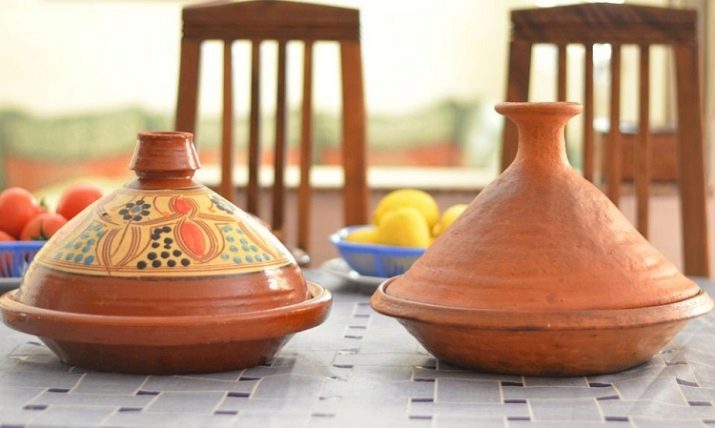
Clay Tajines have one, but a very significant drawback - they absorb odors. If the dishes are used to create different dishes, it will have to be soaked for a long time or separate containers for meat, fish, cereals and sweet food should be made. In addition, the hygiene of clay tajine is also minimal.
Burned glazed versions of dishes devoid of this defect, they are convenient to wash, eliminating unpleasant odors. But the effect of naturally regulating humidity is reduced.
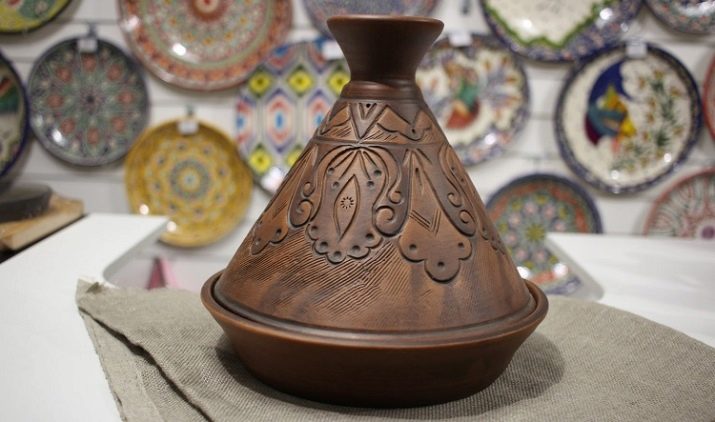
Ceramics
A special type of clay with impurities of mineral origin is also used in the manufacture of modern Moroccan dishes. Ceramic tazhin covered with glaze, baked, acquiring a durable glossy surface. Cookware of this type is usually non-stick, it is suitable for direct installation on an electric stove.
But on a gas burner you will have to use a divider, giving a more uniform heating.An adapter is used on induction surfaces - a metal circle according to the size of the contour of the burner.
Like clay containers, ceramic dishes are different:
- aesthetic appearance;
- environmental safety;
- long preservation of the set temperature;
- optimal conditions for stewing and stewing.
Clay and ceramic containers are not suitable for open fire, they can break or crack, and are not suitable for frying. Otherwise, they are almost impeccable and allow you to maintain the authentic technology of cooking dishes of North African cuisine.
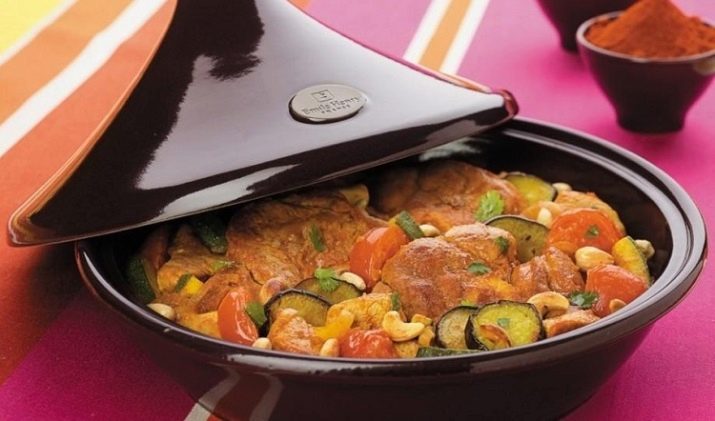
Cast iron
If only a gas stove is available, you can not refuse to use the original dishes of the Moroccan type. Cast iron tajin has excellent heat capacity, not inferior to ceramics. In it, you can pre-fry meat or fish, caramelize vegetables and fruits. The lower part of the cast iron tazhin is suitable for baking dishes in the oven.
The convenience of cast iron tajine is undeniable - it is convenient for cooking on the grill or in the oven, on any type of stove, can be used as a camping option for dishes. An induction hob does not need an adapter: cast iron has ferromagnetic properties. All-metal versions of products are produced, as well as combined ones, with a clay lightweight lid.
When choosing a product, you need to pay attention to the presence of a non-stick coating that prevents the absorption of odors.
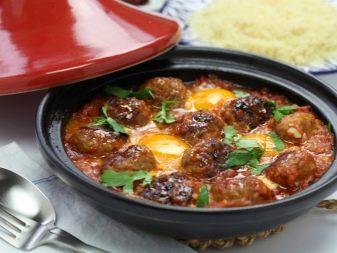
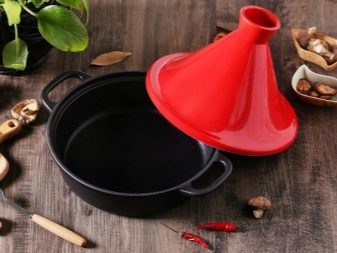
Aluminum
Despite the status of non-ferrous metal, cast aluminum is quite suitable for the manufacture of Tajine base. The top in such models is made of ceramic, lightweight, preventing the weight of the structure. The coating inside the bowl can be made of ceramics, stone, titanium for a slower and more correct heating.
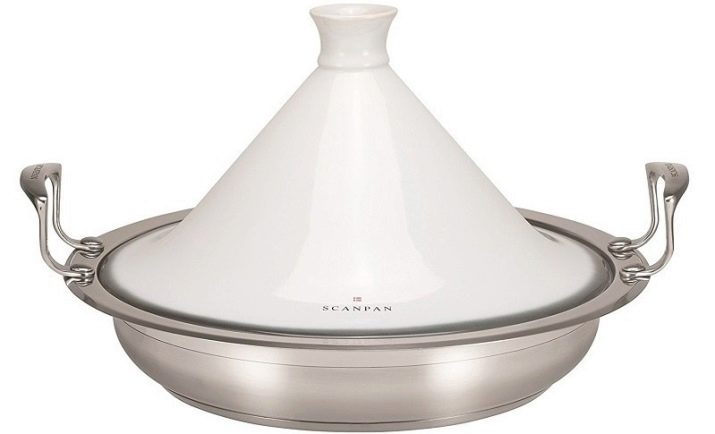
Steel
European manufacturers relatively recently began to produce unusual tazhin stainless steel. Such dishes are complemented by an insert for steaming products. You can even lay the ingredients on several tiers, taking into account the desired temperature and cooking time. In a metal bowl, it is convenient not only to stew, but also to fry, bake.
Ferromagnetic properties allow using induction cookers to put steel tazhin directly on the circuit of the burner. In order for the heat inside the tank to be distributed correctly and evenly, the bottom is made in the form of a multilayer structure with an additional aluminum plate inside the stainless steel layers. But experienced chefs do not recommend replacing ceramic and cast-iron tazhin with steel: heat is lost faster, due to which the cooking technology is violated.
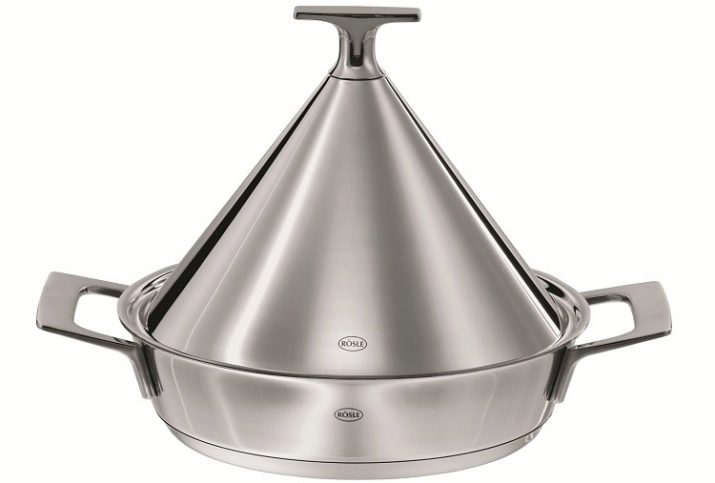
Top manufacturers
The main manufacturers of the correct tagines are companies from Morocco and France.
- Brand Emile Henry produces high quality ceramic tazhin. Products are aesthetically pleasing (their heat-resistant walls are covered with multi-colored glaze), they are practical in care. The dishes are adapted for use with all types of stoves, ovens.
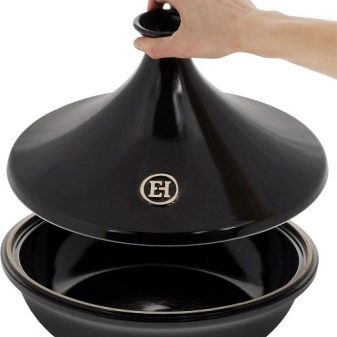
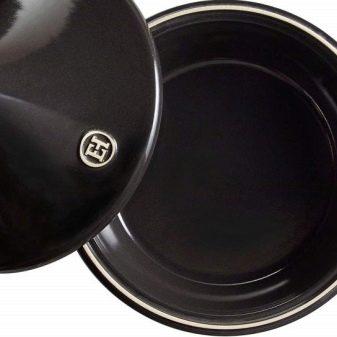
- Staub - A French company that produces magnificent tazhin combined type. The heavy cast iron base has a non-stick enamelled ceramic coating. The dome is ceramic, lighter. The cookware is suitable for direct heating on all types of stoves.
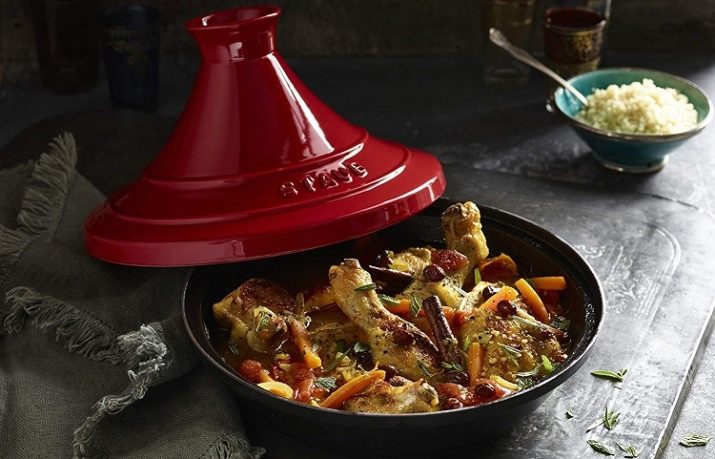
- Le creuset - A French company that produces thick-walled cast-iron dishes of the Moroccan type. The ceramic dome allows you to achieve the effect of traditional languishing, as in a clay pot. You can cook with such dishes on any type of stove. Aesthetic tajine can be served to the table without fear that the dish will cool.
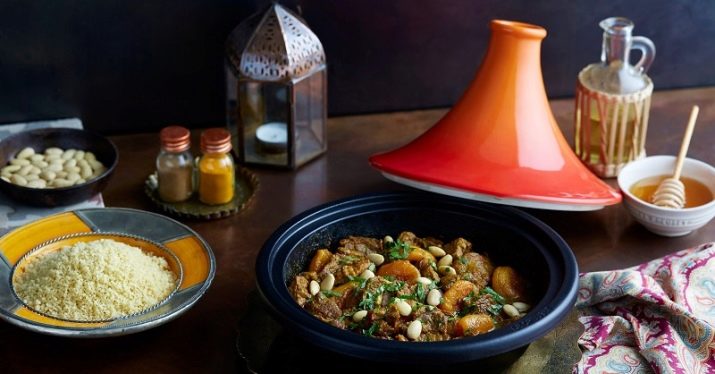
- "Borisov ceramics" - products of the Russian manufacturer. The Moroccan cooking vessels of this brand are distinguished by their affordable cost, wide size range. Products with a dome cover are oriented for baking in a microwave or oven. Direct heating is completely eliminated.
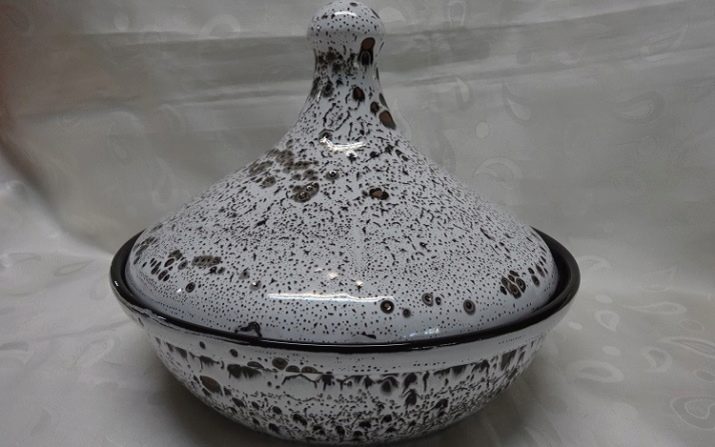
- Vetta. The company produces stainless steel tazhin with a double boiler function. The dishes are lightweight, versatile, easy to care for. But it is rather a pan than an authentic Moroccan vessel.
A detailed description of the Tajine Emilie Henry and other models allows you to get a complete picture of the pros and cons of products of different brands before buying.
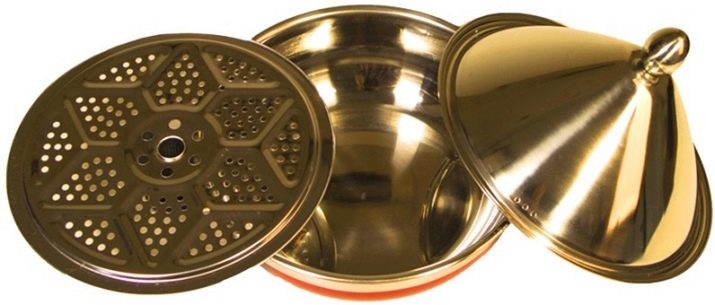
Features of choice
When choosing tajine for cooking in the Moroccan style, you should pay attention to the following points:
- size and diameter: portioned options are convenient for the restaurant, large fryers for the home;
- plate type: metal options are required for induction and gas;
- heating method: in the oven put only dishes of the appropriate height;
- type of heat treatment: it is impossible to fry food in a pottery before stewing.
Ceramic, clay containers and caps should be carefully checked for cracks and chips. It is worth considering the manufacturer's recommendations for specific dishes. They affect the permissible heating temperature, determine the rules for the care of tazhin.
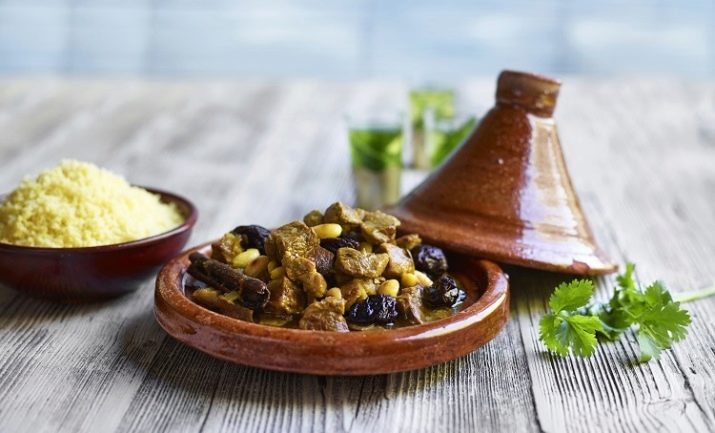
Operation tips
Tazhin is not recommended for use in the oven - the clay part is cracked, but there are special series designed specifically for this method of cooking. Cooking on a gas stove using such utensils is possible, but not too desirable, since it is difficult to control the heating.
An ideal option is an open hearth in which coals smolder. You can get the desired heating intensity on an electric stove, induction or classic with cast-iron, slowly cooling hobs will do.
Because the food in tajine is prepared for a long time, exist certain rules for placing products inside the container. Mutton is laid in it for 10-12 hours. Half the time will be enough for beef, even if the meat is old and tough. For complete readiness of fish and chicken dishes in tajine, 60 minutes are enough.
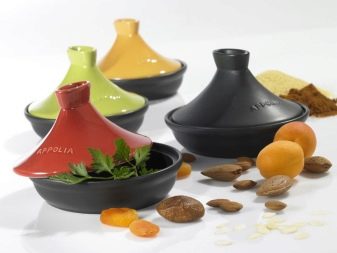
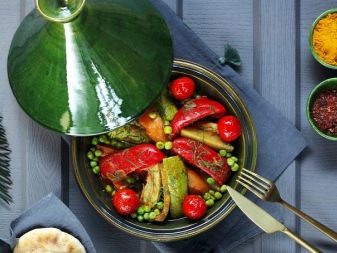
Seafood, vegetables, fruits are cooked no more than half an hour, in complex multi-component dishes they are laid at the very end.
About why tajine is needed and how to use it correctly, see the next video.
